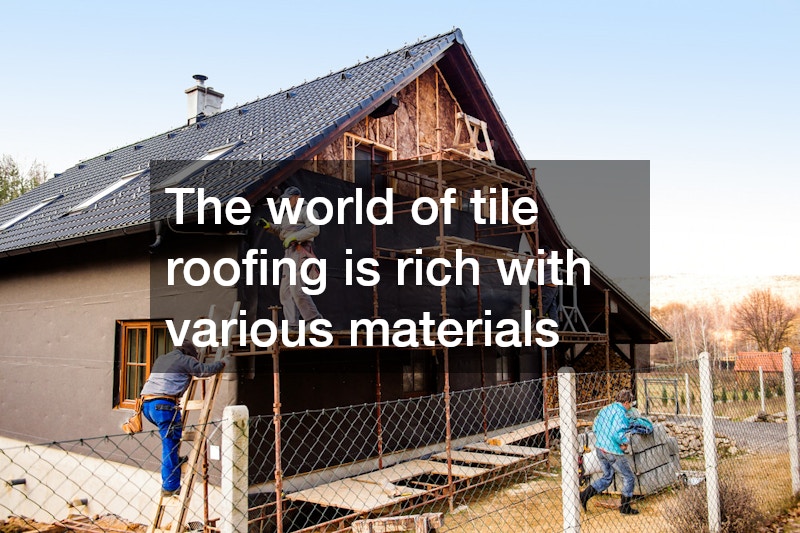Gaining insights into the tile roofing installation process, as explained by expert tile roofing contractors, can help homeowners make better decisions about their roofing. Understanding this process is essential for homeowners who wish to embark on a roofing project that ensures durability and aesthetic appeal. Tile roofing has become increasingly popular due to its longevity and benefits in terms of energy efficiency.
What Are the Key Steps Involved in Tile Roof Installation?
The installation of tile roofing generally begins with a thorough assessment of the existing roof structure. The initial stage involves ensuring that the rafters and decking are in good condition and can support the weight of the tile. Any weak spots or damage must be addressed to ensure a solid foundation for the new roof.
Once the structure is deemed sound, the installation team will proceed with preparing the underlayment. This vital layer serves as a barrier against moisture and offers insulation. A high-quality underlayment, such as a synthetic or felt material, is laid down before the tiles are adhered, effectively protecting the underlying wood from potential leaks.
With the underlayment securely installed, the process of placing the tiles begins. Tile roofing contractors often start from the bottom edge of the roof and work upward, ensuring each tile interlocks properly for maximum protection against the elements. After the tiles are laid, the final stage involves inspecting the entire roof for alignment, installation quality, and the integration of necessary flashing components.
What Types of Tile Are Commonly Used for Roofing?
The world of tile roofing is rich with various materials, each offering unique aesthetic and functional qualities. Clay tiles are among the most popular, recognized for their robust nature and traditional appearance. They are known to be incredibly durable and can last well over 100 years when installed correctly, making them a worthy investment.
Concrete tiles are another common choice, often utilized for their affordability and versatility. These tiles can mimic the look of clay or even slate while providing excellent resistance to weather and wear. Their weight does require additional structural considerations during installation, making expertise in this type necessary.
Slate roofing tiles, although more expensive, are admired for their natural beauty and longevity. They are not only fire-resistant but also non-combustible, providing an additional layer of safety. The installation of slate requires skilled craftsmanship, as each piece is cut to fit precisely on the roof, which can be labor-intensive and time-consuming.
How Do Weather Conditions Affect Tile Roofing Installation?
Weather plays a significant role in the tile roofing installation process, influencing both the timing and techniques used by contractors. Extreme temperatures can affect the sealing properties of roofing materials. For instance, during hot weather, the adhesive used may cure too quickly, resulting in improper bonding.
Humidity is another critical factor to consider, as high moisture levels can hinder the installation of underlayment and tiles. Contractors often monitor local forecasts closely to ensure that installation occurs during a dry spell, reducing the risk of complications. Rain can pose a major threat to both the installation process and the quality of the roof once completed.
Moreover, wind can be an unwelcome challenge during installation. High winds can displace tiles before they are secured, leading to potential gaps and leaks. Many contractors adopt specific safety measures, like securing tiles temporarily until they are fully installed or delaying work until conditions improve to safeguard the quality of the roofing project.
What Are the Common Mistakes to Avoid During Tile Roofing Installation?
One of the most common mistakes in tile roofing installation is improper sequencing. This error can lead to misalignment and insufficient coverage, ultimately compromising the roof’s ability to shed water. Following a strategic installation pattern is crucial to ensuring that the roof functions correctly and maintains a uniform appearance.
Another frequent pitfall involves neglecting to address the underlying structure before beginning the installation. Failing to repair or replace damaged rafters or decking can lead to severe structural issues down the line. Qualified roofing contractors will always emphasize the importance of starting with a sound base to ensure lasting results.
Finally, many homeowners may be tempted to cut costs by choosing lower-quality materials or rushing the installation. While it may seem like a good idea at the time, investing in inferior products can lead to costly repairs and premature roof failure. Expert contractors will guide homeowners in selecting high-quality materials suited to their specific climate and architectural needs.
How Can Homeowners Choose the Right Tile Roofing Contractor?
Choosing the right tile roofing contractor involves careful consideration of several factors, starting with experience. Homeowners should seek contractors who specialize in tile roofing installation and possess a proven track record of quality workmanship. Checking online reviews and requesting references can provide additional peace of mind.
Credentials are also important when selecting a roofing contractor. It is wise to verify that they are licensed and insured, covering both liability and workers’ compensation. These certifications not only protect the homeowner but also indicate that the contractor adheres to industry standards and practices.
Finally, clear communication is essential in the contractor selection process. Homeowners should choose professionals who are open to questions and discussions regarding the installation process, timeline, and estimates. A contractor who invests time in explaining their approach signals commitment and transparency, helping to build trust throughout the project.
Understanding the tile roofing installation process and key considerations can help homeowners make informed decisions and ensure a successful roofing project. By being informed about the materials, weather effects, common mistakes, and how to choose a contractor, homeowners can avoid unnecessary complications. Ultimately, a well-installed tile roof can enhance the property’s value while providing peace of mind for years to come.

